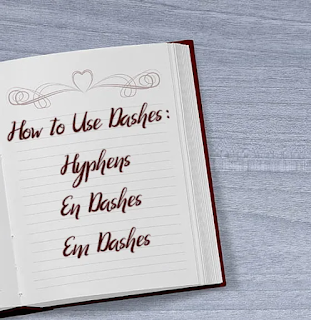Punctuation Time! Dashing Dashes
Note: This article was originally published July 7, 2020 on my now-defunct AMA Creative Solutions website. I have made only the most minor edits in cases of particularly obvious or obnoxious grammatical errors.
There are three different dashes that each have their own purpose. Hyphens are used within words to show a specific meaning. The en dash is most often used in date ranges and point scores. The em dash is a stylistic punctuation mark that is used to reflect a pronounced pause or to highlight specific information. I will be explaining how each of these types of dashes is used in general writing. As always, if you are writing professionally, double-check your organization’s style guide.
Hyphens
Hyphens are placed within words to demonstrate specific meanings or to show that the word continues on the next line. They are entered into a word processor by pressing the dash key (most U.S. keyboards have it placed to the right of the number row) or the minus key on the number pad.
You can use hyphens in some compound words and phrases. Hyphenating compound words is often a stylistic choice, and you can often leave the hyphens out if you prefer. You should not hyphenate adjective/noun compound phrases where the adjective ends in -ly (such as in “poorly executed”).
Example 1: The leasing office nickel-and-dimed their tenants to make as much money as they could.
Example 2: Therese probably wouldn’t have tried the new gadget if the company hadn’t offered a 90-day money-back guarantee.
Example 3: Brendan’s abhorrent behavior was a real eye-opener for some of his staunchest defenders.You can use hyphens to show that a prefix was added to a word. They are most often used when a prefix ends with the same vowel as the word it is modifying or to distinguish the modified word from a pre-existing one.
Example: re-cover, rather than recoverMany professional publishers will use hyphens when a word needs to be separated at the end of a line. They often justify the alignment and hyphenating words prevent awkward spacing in the text. Usually, the hyphenation happens between syllables, but the detailed rules are very specific and outside the scope of this article.
En dashes
En dashes are used to show that two pieces of information are connected and are the length of an “n.” You can enter an en dash into a word processor by either typing Ctrl + [minus on the number pad] or Alt + 0150 on a PC. Here are some of the most common ways that writers use en dashes.
You use an en dash to show a number range, such as page numbers or dates.
Example 1: Jordan was on the tennis team from 1998–2002.
Example 2: The article was published on pages 230–245.
Example 3: The manager scheduled the staff meeting for 8:00a–10:00a, but no one expected it to last the whole time.You can also use the en dash to show sports scores
Example: The home team is winning 4–2 in the fourth inning.You can use the en dash to show how two hyphenated phrases are connected
Example: The teacher was careful to lay clear rules for the pro-choice–pro-life debate.The en dash is also often used when the modifier is two words.
Example: Alice Walker was the first woman of color to write a Pulitzer Prize–winning fiction.
Em dashes
The em dash is a stylistic punctuation mark that is often used in place of commas, colons, and parenthetical phrases. Em dashes create a pronounced pause for the reader, so you should only use it when you want to draw specific attention to a phrase. Most word processing programs automatically transform two dashes (--) into an em dash, or you can use ALT + 0151 on a PC. Here are the reasons some people use em dashes, rather than other punctuation marks.
You can use em dashes to set off parenthetical information, or information you want to add for context, that you want to highlight.
Example: John was very superstitious and blamed everything that went wrong – including his girlfriend breaking up with him, breaking his favorite mirror, and failing his exam – on Mercury retrograde.You would use em dashes an appositive (a noun or phrase that renames a nearby noun) has commas. Usually, appositives would be offset by commas, but em dashes help the reader understand that the appositive is a separate part of the sentence.
Example: Many people fighting for police reform argue that social services – mental health support, community centers, and better quality education – are better suited to serve the community than “broken windows” policies.You can use em dashes to prepare your reader for a list.
Example: Avery explained that the books were organized by genre – horror, science fiction, fantasy, young adult, and comedy.You can use an em dash to reflect a dramatic change in tone.
Example: Alex was proud of his essay and was so excited to read it for the class. He beamed and walked to the front with a huge smile on his face – but couldn’t speak once he saw his classmates staring at him.You can also use an em dash to amplify a description.
Example: I was unprepared to dodge cosplayers at my first anime convention – oversized weapons and gravity-defying wigs everywhere!
References
Grammarly “Dashes” https://www.grammarly.com/blog/dash/
Hacker, Diane (2007) A Writer’s Reference, 6th Ed. Boston: Bedford/St. Martin’s. “The dash.” pp. 290-291.
The Punctuation Guide “Em Dash” https://www.thepunctuationguide.com/em-dash.html
The Punctuation Guide “Hyphen” https://www.thepunctuationguide.com/hyphen.html
UNC-Chapel Hill Writing Center “Semicolons, Colons, and Dashes” https://writingcenter.unc.edu/tips-and-tools/semi-colons-colons-and-dashes/


Comments
Post a Comment